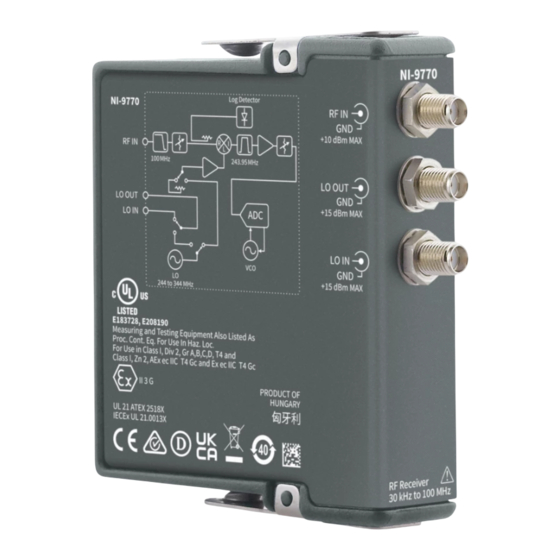
Table of Contents
Advertisement
Quick Links
Advertisement
Table of Contents

Subscribe to Our Youtube Channel
Summary of Contents for NI 9770
- Page 1 NI-9770...
- Page 2 GETTING STARTED GUIDE NI 9770 30 kHz to 100 MHz, 50 Ω, AC Coupled RF Receiver Module...
-
Page 3: Safety Guidelines
This document explains how to connect to the NI 9770. Before you begin, complete the software and Note hardware installation procedures in your chassis documentation. The guidelines in this document are specific to Note the NI 9770. The other components in the system might not meet the same safety ratings. -
Page 4: Safety Guidelines For Hazardous Locations
+15 dBm Safety Guidelines for Hazardous Locations The NI 9770 is suitable for use in Class I, Division 2, Groups A, B, C, D, T4 hazardous locations; Class I, Zone 2, AEx nA IIC T4 and Ex nA IIC T4 hazardous locations; and nonhazardous locations only. - Page 5 Zone 2 hazardous locations, in ambient temperatures of -40 °C ≤ Ta ≤ 70 °C. If you are using the NI 9770 in Gas Group IIC hazardous locations, you must use the device in an NI chassis that has been evaluated as Ex nC IIC T4, Ex IIC T4, Ex nA IIC T4, or Ex nL IIC T4 equipment.
-
Page 6: Electromagnetic Compatibility Guidelines
To minimize interference with radio and television reception and prevent unacceptable performance degradation, install and use this product in strict accordance with the instructions in the product documentation. NI 9770 Getting Started Guide | © National Instruments | 5... -
Page 7: Special Conditions For Marine Applications
LR certificate, or look for the Lloyd’s Register mark on the product. In order to meet the EMC requirements for Caution marine applications, install the product in a shielded enclosure with shielded and/or filtered power and 6 | ni.com | NI 9770 Getting Started Guide... -
Page 8: Preparing The Environment
EMC performance is attained. Preparing the Environment Ensure that the environment in which you are using the NI 9770 meets the following specifications. Operating temperature -40 °C to 70 °C... - Page 9 Connecting the NI 9770 The NI 9770 provides connections for one RF input, one local oscillator input, and one local oscillator output. 8 | ni.com | NI 9770 Getting Started Guide...
- Page 10 Figure 1. NI 9770 Pinout RF IN LO OUT LO IN NI 9770 Getting Started Guide | © National Instruments | 9...
- Page 11 NI 9770 as a standalone module. Connecting the NI 9770 to a Device Under Test You can connect the NI 9770 to the equipment under test through a current transformer. The current transformer provides electrical isolation between the equipment under test and the NI 9770 and allows the NI 9770 to measure high-frequency currents flowing into the ground connection of the equipment under test.
- Page 12 You must use a coaxial cable with an SMA Note connector to connect to the NI 9770. Figure 2. Connecting a Current Transformer to the NI 9770 To Machine Neutral Current Transformer RF IN NI 9770 NI 9770 Getting Started Guide | © National Instruments | 11...
-
Page 13: Where To Go Next
Where to Go Next Hardware Software NI-RIO Help NI 9770 Datasheet LabVIEW Help LabVIEW FPGA Help RELATED INFORMATION C Series Documentation Services & Resources ni.com/services ni.com/info cseriesdoc Located at ni.com/manuals Installs with the software 12 | ni.com | NI 9770 Getting Started Guide... -
Page 14: Worldwide Support And Services
You can obtain the DoC for your product by visiting ni.com/certification. If your product supports calibration, you can obtain the calibration certificate for your product at ni.com/calibration. NI 9770 Getting Started Guide | © National Instruments | 13... - Page 15 National Instruments Patent Notice at patents . You can find information about end-user license agreements (EULAs) and third-party legal notices in the readme file for your NI product. Refer to the Export Compliance Information at ni.com/legal/export-compliance for the National Instruments global trade compliance policy and how to obtain relevant HTS codes, ECCNs, and other import/export data.
















Need help?
Do you have a question about the 9770 and is the answer not in the manual?
Questions and answers